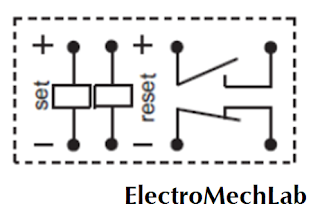What is a Bistable Relay?
A bistable relay, also known as a latching relay, is an
electromechanical device that has two stable states. Unlike conventional relays
that require continuous power to maintain their state, bistable relays can hold
their position without a constant power supply. This characteristic makes them
energy-efficient and suitable for applications where power consumption and
space are critical factors.
Operation Principle
The operation of a bistable relay is based on the principle
of mechanical latching. It consists of two coils, a set coil, and a reset coil,
which control the relay's two stable positions. When current flows through the
set coil, it generates a magnetic field that attracts the relay's armature,
causing it to physically move and latch into position. The relay remains in
this state even after the current is removed.
Similarly, applying current to the reset coil generates an
opposing magnetic field that pulls the armature back to its initial position,
latching it there until further input is provided. The bistable relay thus
retains its state until an appropriate signal is received to change it.
Applications of Bistable Relays
1. Energy-Efficient Switching: Bistable relays find use in
energy-efficient switching applications, such as controlling lighting systems,
where the relay's state doesn't change unless explicitly commanded, reducing
unnecessary power consumption.
2. Automotive Systems: Bistable relays can be found in
automotive applications, such as power windows, door locks, and sunroofs. They
help maintain the desired position until a change is requested.
3. Industrial Automation: In industrial settings, bistable
relays are utilized for tasks like controlling conveyor belts, pumps, and motors.
Their ability to maintain state without continuous power is advantageous in
scenarios where power interruptions are common.
4. Home Appliances: Bistable relays play a role in various
household appliances, including washing machines, microwave ovens, and coffee
makers. They contribute to efficient and reliable control of these devices.
Advantages of Bistable Relays
1. Energy Efficiency: Bistable relays consume significantly
less power compared to traditional relays since they do not require continuous
power to maintain their state.
2. Space Savings: Their compact size and ability to maintain
state without power make them suitable for applications where space is limited.
3. Reliability: Bistable relays are more reliable in
scenarios with frequent power fluctuations or interruptions since they hold
their position regardless of power supply variations.
4. Longevity: Reduced power consumption and minimal wear and
tear on the contacts contribute to the bistable relay's extended operational
life.
Limitations and Considerations
While bistable relays offer numerous benefits, they are not
suitable for all applications:
1. Higher Complexity: Bistable relays are often more complex
to design and manufacture compared to standard relays.
2. Initial Setup: The initial setup to change the relay's
state may require additional control circuitry.
3. Limited Switching Speed: Bistable relays may have slower
switching speeds compared to traditional relays due to the mechanical movement
involved.
4. Cost: Bistable relays might be more expensive upfront due
to their specialized design.
Conclusion
Bistable relays provide a fascinating solution to the
challenges of energy efficiency and reliable control in various applications
across industries. Their ability to maintain a stable state without continuous
power supply makes them indispensable in scenarios where power consumption,
space constraints, and reliability are critical factors. As technology
continues to evolve, bistable relays are likely to find new and innovative applications,
driving further advancements in the field of electrical and electronic
engineering.
